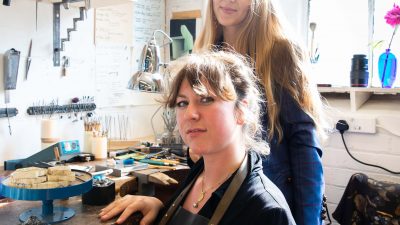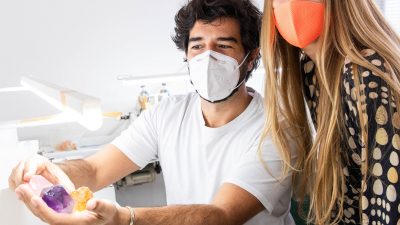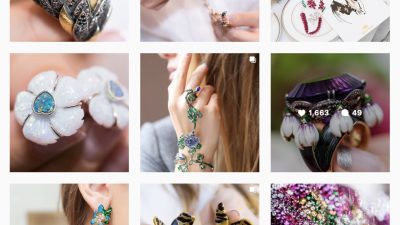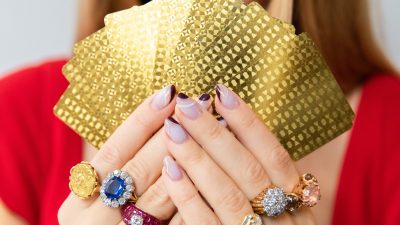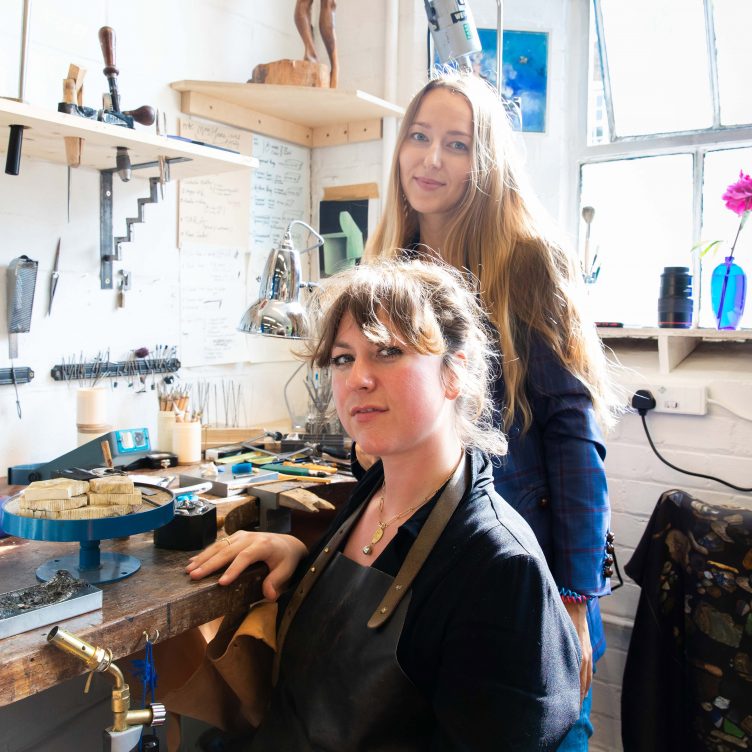THE CRAFTSMANSHIP OF JOY BONFIELD-COLOMBARA: HOW THE PRECIOUS TEAR RING CAME TO LIFE
THE CRAFTSMANSHIP OF 2022 edition… is dedicated to the fabulous craftsWOMEN that I have met on my travels around the world. In this series, I aim to debunk preconceived notions of jewellery-making as a men only craft and open the doors to some incredible female jewellery makers. From incredible designs, wax carving to metalwork and skilful gem-setting and craftsmanship, this series will follow the journey of exquisite jewels crafted by women.
Discover THE JEWELLERY CRAFTSMANSHIP OF… Joy Bonfield-Colombara and how the Precious Tear Ring came to life.

JOY BONFIELD – COLOMBARA
I spent a wonderful morning with rising goldsmith star and acclaimed artist, Joy BC, getting to know the mastery and inspiration behind her wearable works of art and miniature jewellery sculptures. I spotted some of Joy’s pieces in London before my spontanoues 5 months visit to Brazil and instantly knew I had to meet her. I call it jewellery-love at first sight! As you know, this is a rare occurrence.
I visited Joy BC at her studio in Central London, where she crafts her jewels. As soon as I stepped into the studio, there was such a positive energy about her that I just wanted to surround myself in her jewellery orbit. We had a delightful conversation about art, sculpture and jewellery; the whole experience was truly unique. Not only did I leave with an extraordinary ring, but a friend for life!
View this post on Instagram
Joy was taught by two master goldsmiths at the Glasgow School of Art, before completing her M.A. in Jewellery and Metal at the Royal College of Art in London. From there, it was off to Kyoto to study at Japan’s oldest art school. It was insightful to hear how her studies in the ancient art of urushi, under the tutelage of master craftsmen Sensei Ando and Sensei Kagaeyama, experts in Damascus steel and metal casting, shaped her perception of jewellery and craft.

“The Japanese have such an amazing appreciation, respect and understanding of high craft. In Japan, the words ‘art’ and ‘craft’ are not separate, they’re one in the same. So the way each piece is made is integral to the final work. It absolutely defines the way I make jewellery.” Joy Bonfield – Colombara
INSPIRATION BEHIND THE JEWEL
I find the inspiration behind the Precious Tears fascinating. The thought that has gone into the meaning of tears for Joy lies in the science of the human body. She explains that there are three types of tears: One keeps the eye lubricated and free of dust, one removes irritants (think of cutting an onion), and one falls when we feel emotional stress, such as pleasure, anger, suffering, mourning, or physical pain. Whatever the type of tear, for Joy, they are all precious.
The Precious Tears collection is an ongoing body of work and explores Joy’s belief in how precious they are.
“By transforming an ethereal liquid tear into a hard stone sapphire in this ring, I am putting emphasis on the strength it takes to show one’s vulnerabilities. By engaging with this ‘totem’, the wearer becomes the owner of their vulnerability and honestly confronts that aspect of them-self that we often choose to ignore or suppress.” Joy Bonfield-Colombara

Joy’s words remind me of a quote from the book, Daring Greatly that I am currently reading by Brené Brown:
“What we know matters, but who we are matters more. Being rather than knowing requires showing up and letting ourselves be seen. It requires us to dare greatly, to be vulnerable.”
Sometimes we need to carry a reminder of this and wearing an objet d’art on our finger is just the thing. Jewellery is such a powerful token and talisman. It gives us the insight to stay in tune with ourselves. JOY BC’s Precious Tears is a collection of jewels with a big impact.
LINES
Joy’s jewellery art is very personal and inspired by family roots and traditions. By observing and admiring famous sculptors like Michelangelo, Barbara Hepworth, Rodin and many others who have worked with hand tools, not pneumatic drills, she became interested in all the markings in the stone, tiny little lines at the edges made by the master sculptor’s hand.
These lines reminded Joy of the time she would spend with her father as a child, working in his studio. Joy would take a piece of paper and draw tiny little lines to make a design and her father would take it and sculpt something, using a rasp to smooth the edges and create a smooth surface.
The lines in Joy’s work represent her English side of the family. Her father is a sculptor. His lineage goes back to 12th century Croatia and the Island of Prvić. For hundreds of years, they were a family of stone masons, carving and digging stone from the earth in the Bonfield mines. To this day, Joy’s father uses hand tools and a dog-tooth chisel to carve loads of tiny little lines in the stone.

As natural beings, Joy doesn’t believe in the separation of nature in art, but sees it as an experience of all living things. By carving tiny lines into the stone, you interact with the material and give it life through movement. When you look at Barbara Hepworth’s pieces or Rodin’s, you see the markings in the stone like a conversation between artist and material. Joy likes to focus on these gorgeous markings and make it a feature in her work, because it shows the artist’s hand at work and the signature way each craftsperson brings texture and life to their works.
In a lot of Joy’s drawings or sketches, you’ll see a three-dimensional movement. It helps her to understand the material of the piece and makes it more stylistic. So it’s not just about the technique and leaving those markings. She purposefully put those lines back in to make it her signature marking.

“Michelangelo is a really interesting example. His first ever Pietà of Jesus with Mary and Jesus dying in Mary’s arms is completely smooth and he’s very young and he’s trying to emulate exactly what skin looks like. It’s an imitation of nature in the perfect sense and it’s all completely smooth. As he gets older, he starts to leave the marks, these little tiny lines in the artwork. So the second Pietà he did, the front is smooth, the back has all the markings and you start to see the markings around the feet. The last piece he made before he died, which I think is the most beautiful, one of the best pieces of sculpture ever made, which is now in Milan, is completely covered in the marks, and you can see the movement of Michelangelo working the material around. It’s so emotional. It’s no longer about striving for perfection.” Joy Bonfield-Colombara
CRAFTSMANSHIP
From conception to finished piece, Joy puts various processes into practice to make the Precious Tear ring. From time, patience, skill, art, research, casting, gemstone cutting and artistic integrity, Joy’s creative energy is in every line and molecule of the piece of work.
She meticulously carves the face with the light hand of an artist and creates a mould. Carving for Joy takes her to a Zen space, something she brought home from Japan. They really believe that if you spend enough time with an object, it will reveal its secrets to you. She loves netsuke carving and the patience it takes to craft each piece. It’s a labour of love.
“If you spend time with an object, it will reveal its secrets to you.” Joy Bonfield-Colombara

After Joy is finished carving the model, she is ready for the lost-wax casting stage. Hot wax is poured into the gap between the model and the mould, forming a seal around the carving. A space is created between the clay model and the mould, which makes it easier to remove once set.

She then creates the gold collar by melting recycled gold. Then it goes into water, followed by acid. She rolls it down with a heavy-duty rolling mill to 1.2 thickness, which is quite wide, but just the way Joy wants it.

“Making the ring by hand rather than by machine takes greater effort. It’s a labour of love. I believe that what you feel transcends into the object. So everything I make is made with intention.” Joy Bonfield-Colombara

For the setting, Joy uses a thicker wall of gold to set the stones, which gives the tear its signature look. Timing is everything. When you pass the metal through the rolling mill, it hardens and the molecules become compressed. You can only work it to a certain point until it becomes overworked and will start to crack. Each time you heat the metal, you lose some of the molecular structure.

Once the ring, the face, and the eye are soldered together, the final touch is setting the sapphire gemstone. It is a magical moment, when the whole piece is most vulnerable.

What a truly special experience it was to be in the presence of a jewellery artist like Joy BC. To understand all stages of the process and see how much love, creativity and sometimes strength is needed to bring a piece of jewellery to life was extraordinary. I was enthralled by the carving technique and how technical and exciting it can get with flame and heavy machinery in the hands of a woman! It was an empowering experience and I hope after reading and watching the process, you will never look at a piece of jewellery the same way again.

HERE IS THE MESMERISING SUMMARY OF THE PROCESS JOY FOLLOWS WHEN CREATING HER JEWELS:

- Wax can be formed into nearly any shape imaginable. This ring is born through meticulously carving the face in wax with a light hand to create a mould.
- The next stage is casting using the lost wax technique (so-called because the wax model is destroyed or lost when the metal is cast). Once casted the face is recarved every single time, for every single ring.
- After more polishing and more line carvings, a gold collar is created by melting recycled gold.
- The gold collar is then rolled with a heavy-duty rolling mill which gives life to the wide wall Joy likes to use for the setting.
- Lastly, the magic happens! Joy solders the ring, the face, and the eye together before adding the final touch: The dreamy sapphire is set, which gives this jewel the ability to capture and carry a moment of vulnerability. A soul-enriching jewel for whoever gets to wear it.

You can sign up for GEMOLOGUE newsletter below and I also share jewellery on Instagram, Twitter, Facebook and Youtube if you’d like to connect, or feel free to say hello info@gemologue.com
GEMOLOGUE jewelry blog by Liza Urla is a celebration of fine, fashion and vintage jewellery featuring talented jewellery designers, trendy urban street style, exclusive interviews and rare jewellery reviews. This jewellery blog’s goal is to encourage and educate about jewellery online in a fresh and original fashion to inspire women and men across the globe in a fashion and travelling context.
Jewellery blogger, writer Liza Urla, the founder of GEMOLOGUE, is a London-based and NYC-educated gemologist, who has travelled to and lived in many countries. She is now one of the most influential digital jewellery tastemakers. Her jewellery influence has been acknowledged by Financial Times, The New York Times, Vogue and Harper’s Bazaar.
*Styling and Art Direction by Liza Urla. All photos belong to GEM Kreatives for GEMOLOGUE.
Material on this website may not be copied, broadcasted or adapted without written consent.

